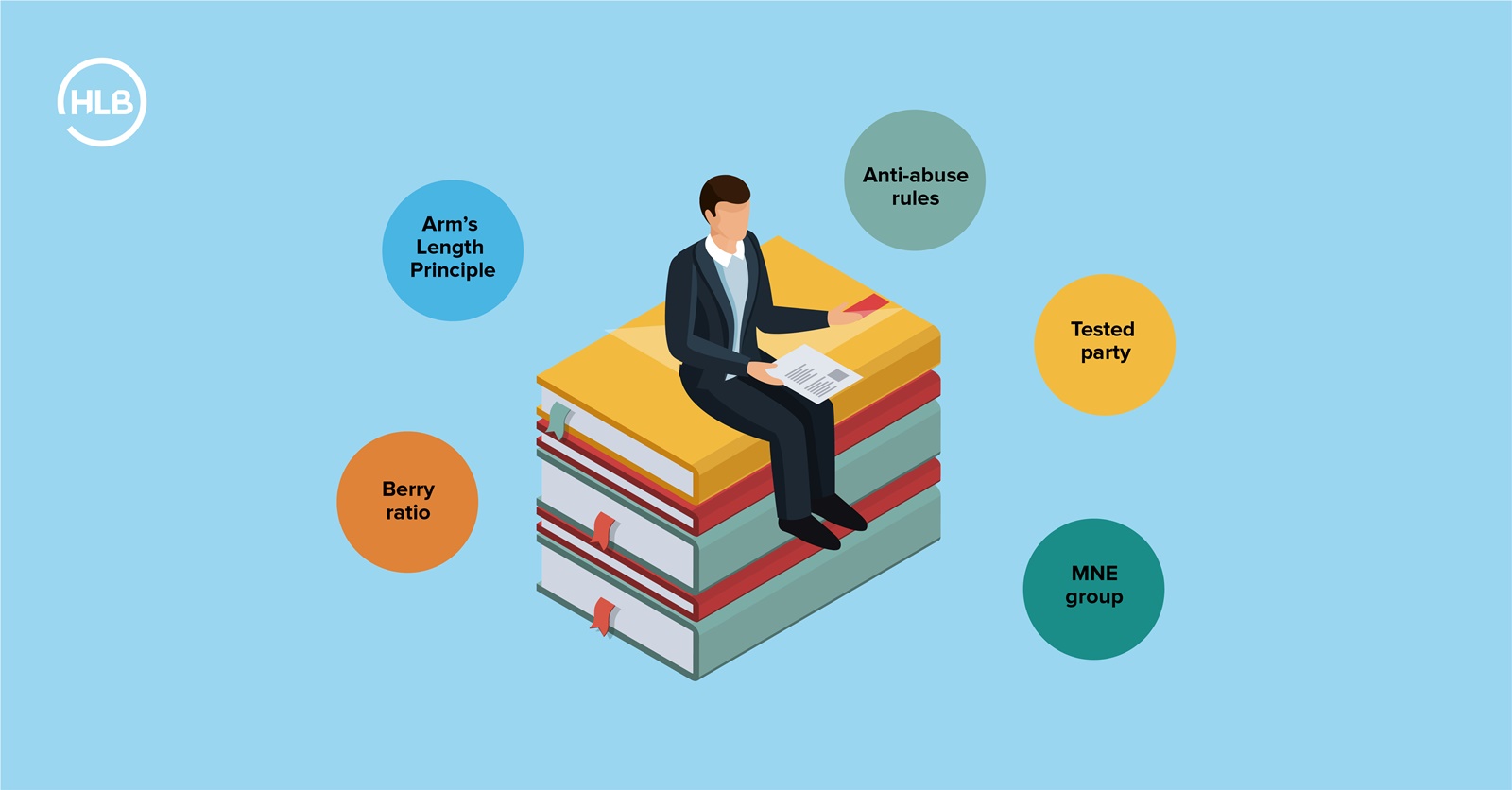Transfer Pricing Terminology Broken Down and Explained
HLB Thailand Transfer Pricing Team
At HLB Thailand, we want Transfer Pricing to be accessible to everyone. We understand that it’s easy to get lost in the jargon, so we’ve put together this easy to search glossary to lend a hand.
It is by no means exhaustive, but it’s a convenient place to start your Transfer Pricing journey. If you’re going to deal with transfer pricing, these are the 30 or so terms you’re going to need to know.
Anti-abuse rules and Anti-avoidance laws
These are some of the domestic taxation laws that you might run afoul of if you get transfer pricing wrong – they’re specifically aimed at ensuring people within a tax jurisdiction are paying the right amount of tax on their business profits as well as with punishing those who attempt to evade or reduce their tax contributions.
Arm’s Length Principle
The Arm’s Length Principle is an international standard set out by the OECD. It’s used for determining transfer prices and ensuring that controlled transactions are made at “arm’s length”. It ensures transfer prices between related parties are equivalent to prices unrelated parties would charge in the same or similar circumstances. This involves identifying situations or transactions undertaken by unrelated parties that are comparable to the situations or transactions between related parties. Many countries have addressed Transfer Pricing risks by introducing domestic rules based on the Arm’s Length Principle.
Arm’s Length Range
This is the range of financial figures used to establish whether or not the Arm’s Length principle has been met. Arm’s Length Ranges are generated by looking at the comparable Arm’s Length data. You’ll need to make sure that your particular Transfer Pricing method produces a result that lands within the Arm’s Length Range. We’ll look into the various Transfer Pricing methods you might use in just a bit.
Associated/Related enterprises, companies, or parties
These terms are commonly used for companies who share ownership and/or common management control and would be subject to transfer pricing rules if they transact with one another.
In Thailand, the Transfer Pricing laws state that two companies are considered related parties if:
1. One entity holds shares in or is a partner of the other entity, either directly or indirectly, of not less than 50
percent of the other entity’s total capital;
2. A shareholder that holds shares, either directly or indirectly, of not less than 50 percent of the entity’s total
capital, holds shares in another entity, either directly or indirectly, of not less than 50 percent of the entity’s
total capital; or
3. Entities are related in the capital, management, or control so that an entity may not operate independently
from the other entity, as prescribed by Ministerial Regulations.
Related parties must deal with each other at Arm’s Length and their transactions are subject to Thai Transfer Pricing legislation.
Independent enterprises
"Independent enterprises" refer to unrelated companies operating in a competitive market. When setting transfer prices between related entities, tax authorities compare them to prices charged between independent companies to ensure fairness and compliance with the arm's length principle.
Controlled transactions
These are transactions that occur between two related companies or entities. If you’re selling goods to a company that you own 50 percent or more of the shares in, that’s a controlled transaction. , so-called because you’re able to assert more control over the prices agreed than you would if you didn’t own a majority stake in the other company.
Uncontrolled transactions
These are transactions that occur between unrelated companies and which are therefore not subject to Transfer Pricing regulations.
Functional analysis
Functional analysis is a breakdown of the critical functions, use of assets and assumption of risks undertaken by all related businesses involved in a controlled transaction. These can then be compared against similar figures from uncontrolled transactions with independent enterprises – again, it’s all about proving that you’ve followed the Arm’s Length Principle.
Functional analysis is a key part of comparability analysis and is the foundation of all Transfer Pricing analysis as a whole. The OECD Transfer Pricing Guidelines consider the assumption of risks to be a crucial part of the functional analysis, as the assumption of greater risks carries the expectation of greater profits.
Benchmarking
This is how you assess whether your controlled transactions are being priced fairly. A scientific methodology is required to arrive at the most suitable comparable companies to serve as benchmarks. Thailand prefers you benchmark your transfer prices against those of local companies – if you’re selling goods to a related company, how much would your related company be able to buy those goods for if they were purchasing from a local company rather than your own? This is benchmarking.
Comparability Analysis
This is how you go about making sure that your transfer prices are set at the going market rate. By comparing the controlled transactions your company is involved in with legally comparable uncontrolled transactions, you’ll be able to see if you’ve applied the Arm’s Length Principle correctly. You’re likely to encounter at least a few complicating factors while running your analysis, so it’s best to consult an expert who can convincingly weigh them up against the going market rate.
Comparable companies
This is where you compare a controlled transaction with an uncontrolled one – but the two are only legally comparable if there are no factors that could conceivably be regarded as different. It’s simply a case of making sure that factors are taken into account when making the comparison, and this comparison could then be used to calculate a transfer price that meets the Arm’s Length Principle and keeps you on the right side of compliance. (see our article on Thailand clarifies rules for use of internal and external comparables to get more insights into this subject)
Berry ratio
The Berry ratio is a simple calculation used in Transfer Pricing to indicate whether or not a company is making a profit on its value-added activities. You can calculate your Berry ratio by dividing your gross profits by your operating expenses. This measurement is most applicable to service providers who can calculate the remuneration for value-added functions. Under the Berry ratio, the mark-up is applied to the operating expenses that represent the remuneration only for the value-added functions but excludes the cost of goods sold. Under the Berry ratio, the mark-up is applied to the operating expenses or value-added expenses representing the remuneration only for the value-added functions, excluding the cost of goods sold. The Berry ratio application is subjective, and you’ll need an expert to navigate you through its applicability to your business.
CFC (Controlled Foreign Corporation)
A CFC is a subsidiary or related entity of a multinational corporate group that’s located in a foreign jurisdiction. Some countries have introduced CFC legislation into their tax laws designed to limit artificial deferral of tax by using offshore low taxed entities.
Year-end/Voluntary Adjustment
This adjustment is one your company would make before you file your tax returns. It’s basically where you report a transfer price from a controlled transaction your company has taken part in and adjust the price that was actually set in the transaction to one that the taxpayer – you – consider in line with the Arm’s Length Principle. (Refer to our article on Year-end transfer pricing adjustments and customs valuations to get more insight)
Intragroup or Intracompany service
This is the rendering of a service to a related company – one that you’ll need to make sure is paid or received at the same rate that an independent enterprise could have provided the same service for.
Direct Charge method
This is one of the many methods of charging for an intragroup service. The Direct Charge Method requires a clearly identified agreement outlining how the transaction will be conducted. Speak to us for more info on this. . (See our article where Thai Revenue Department mentioned what they want to see for service transactions transfer pricing documentation and adjustment rules clarified)
Direct Costs
Direct costs are associated with the production of goods or the rendering of a service – raw materials, equipment needed to process the raw materials, the paying of salaries to those producing the goods or providing services etc.
Indirect Charge Method
This is just another of the potential methods you can use to calculate the agreed price in an intragroup or intracompany transaction. Each transaction will have a preferred method, so speak to us directly for more info on which one to choose and how to make it work for you.
Indirect Costs
These are costs not directly related to the production of goods or the rendering of services. Indirect costs include overheads like the petrol used for delivery, repairs on vehicles or machinery, software updates and the like.
Double Taxation Treaty
A double taxation treaty or agreement is made between two countries to ensure that enterprises operating in both tax jurisdictions won’t be taxed twice by two different regimes. Most double tax treaties incorporate the Arm’s Length Principle as a basis for allocating profits (and thus taxes) between associated enterprises.
Intangibles
An ‘intangible’ is something that belongs to a company but is not a physical or financial asset. They include things like intellectual property or organizational know-how. Intangibles generally fall into one of two groups, marketing intangibles and trade intangibles.
- Marketing intangibles are used in customer-facing business operations and include things like
trademarks, trade names, customer lists and customer relationships. - Trade intangibles have more to do with internal operations and include things like patents, know-how,
designs and models used for the production of goods or the provision of services.
Whenever a company’s intangible assets are used for commercial purposes by another party, a royalty rate will be agreed upon, either as a fixed value or as a percentage (depending on the license agreement) of the revenue gained through their use.
Intentional Set-Off
An intentional set-off is when a related company benefits from the actions of another related company. In order for the benefits to be mutual, the parent company or the two related companies will agree to find a means of repaying the benefits in one form or another. Intentional set-offs can get messy so you’ll want to be sure that your documentation is in order to prove that everything is above board. More on intentional set-offs and incidental benefits can be found under Chapter VII, section B. 1.4 of the OECD’s BEPS Action Plan 13.
Multinational enterprise group (MNE group)
This is a group of multinational companies that all share a common owner or are controlled by the same legal entity despite operating in more than one country.
Read More: How Country-by-country reporting (CbCR) regulations are evolving in Thailand
Multinational enterprise (MNE)
This is a company operating in more than one country that belongs to a larger group or parent company.
Read More: What’s the difference between a Master file and a Local file?
OECD Transfer Pricing Guidelines
Published for the first time in 1995, the Organisation for Economic Co-operation and Development (OECD) has been the leading organization in developing global transfer pricing guidelines. Thailand is adopting very similar rules to the OECD’s, but because they are not exactly the same you’ll always want to consult a local specialist to ensure your documentation requirements have been met.
Transfer Pricing Adjustments
This is an adjustment made by a tax authority for revenues or expenses generated from controlled transactions that fail to satisfy the Arm’s Length Principle. Transfer Pricing adjustments can be applied to controlled transactions occurring within the same or multiple tax jurisdictions.
Can the Thai Revenue Department adjust the counterparty to the controlled transaction? Refer to our article on transfer pricing documentation and adjustment rules clarified to get more insight.
Repatriation of Funds
This is just the returning of profit to a related company if you’re found to deviate from the Arm’s Length Principle when carrying out a controlled transaction. The potential consequences for tax evasion are catastrophic, so it’s best to avoid them altogether.
Tested Party
A tested party refers to a participating related company in a controlled transaction – typically it’s used to refer to a company whose functions, risks and assets are the least complex in the transaction and whose data is easily available for analysis in the public domain.
Transfer Pricing
This is the price applied to transactions between related companies, including adjustments made to ensure that the price is similar to what would have been paid if the companies were entirely separate from one another.
Read More: Everything you’ve ever wanted to know about Transfer Pricing in Thailand
Transfer Pricing Methodologies
There are many methods you can use to calculate Transfer Pricing in accordance with the Arm’s Length Principle. These include:
Traditional Transaction Methods: The Comparable Uncontrolled Price (CUP) method, Resale Price Method (RPM) and the Cost Plus Method (CPM) are considered traditional transaction-focused methods for establishing the Arm’s Length Principle in Transfer Pricing.
- Comparable Uncontrolled Price (CUP) Method: This method compares the price of goods or services in a controlled transaction against the price of similar goods or services in a similar uncontrolled transaction. The key here is comparability in terms of product, price, circumstances, location and terms and conditions of the arrangement.
- Cost Plus Method: This method uses the costs incurred by the supplier of the goods or services in a controlled transaction to determine an appropriate transfer price. This method requires you to add a mark-up on the costs to determine an appropriate profit in light of the functions performed and risks assumed. You’ll need to be sure you’ve taken functions and risks as well as current market conditions into account. Once you’ve added the mark-up on the costs, you should have a transfer price in line with the Arm’s Length Principle.
- Resale Price Method: This method looks at how much a product could be resold to an independent company after it has been purchased from a related company in a controlled transaction. The resale price is reduced by the resale price margin. What is left after subtracting the resale price margin can be regarded, after adjustment for other costs associated with the purchase of the product (e.g. custom duties), as the arm’s length price of the original transfer of property between the associated enterprises. This is based on the gross margin realised in comparable uncontrolled transactions. This method is generally used for pure distributors that resell products without physically altering them or adding substantial value to them.
There are various factors or deficiencies in the application of CUP, CPM, or RPM – you’ll need an expert to help you select the most appropriate method to analyse the controlled transaction.
Transactional Profit Method: Profit Split Method (PSM) and Transactional Net Margin Method (TNMM) are considered traditional profit-focused methods for establishing the Arm’s Length Principle in Transfer Pricing.
- Profit Split Method: This method looks at how profits ought to be split in a controlled transaction. The goal is to produce the approximate division of profits that would have been found following a transaction that meets Arm’s Length standards. The approximate division is based on combined profits derived by the counterparties to the transaction. This method is mostly used in highly-integrated or complex controlled transactions involving the creation of an intangible asset.
- Transactional Net Margin Method: The TNMM examines the net profit that a company derives from a controlled transaction relative to an appropriate base (e.g., costs, sales, or assets). Typically, TNMM is used as financial data on comparable independent companies that are commonly publicly available. Moreover, TNMM is also more tolerant of accounting inconsistencies. Its use of net operating profit analysis, which naturally captures both cost of goods sold and operating expenses, allows for a more consistent comparison of financial results, albeit differing accounting treatments to cost classification.
Transfer Pricing Disclosure Form
In Thailand, the transfer pricing disclosure form is a report which includes details of related parties and transactions during the year with related parties. A company must file this form if its annual revenues are greater than THB 200 million. The form must be filed online on or before the corporate income tax return filing date.
Read More: The impact of COVID-19 on your Transfer Pricing arrangements
HLB’s Transfer Pricing specialists are here to help.
Thailand’s Transfer Pricing rules are complex, and can differ greatly from those in neighbouring countries. To stay compliant, book a meeting with Rohit Sharma and his team of local Transfer Pricing experts at HLB Thailand today.











